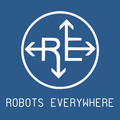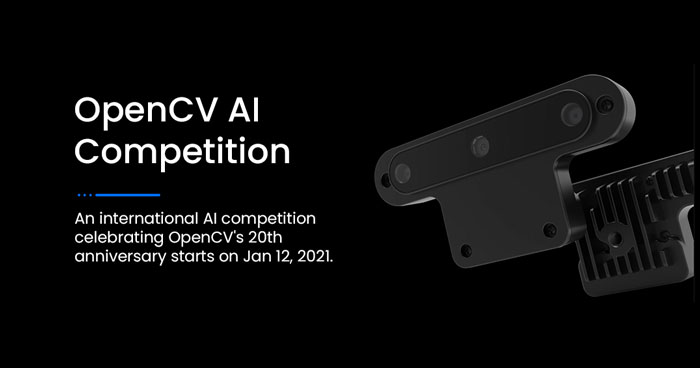 Greetings all, welcome to the penultimate Hack Chat of 2021! I'm Dan, and as usual I'll be modding today along with Dusan as we welcome Erik Kokalj to the chat. Erik works on spatial AI at Luxonis, and we're going to go into depth about spatial AI and CV.
Greetings all, welcome to the penultimate Hack Chat of 2021! I'm Dan, and as usual I'll be modding today along with Dusan as we welcome Erik Kokalj to the chat. Erik works on spatial AI at Luxonis, and we're going to go into depth about spatial AI and CV.
 Sorry, I had to...
Sorry, I had to...
Erik, are you out there yet?
 Hello and welcome!
Hello and welcome!
 yay!
yay!
 Hello everyone!
Hello everyone!
 hi
hi
 Hey, welcome, great to have you today. Can you tell us a little about yourself, and maybe how you came to be working in machine vision?
Hey, welcome, great to have you today. Can you tell us a little about yourself, and maybe how you came to be working in machine vision?
 Sure, so I am a software engineer with an electrical engineering background. I come from Slovenia, Europe and I am opensource enthusiast
Sure, so I am a software engineer with an electrical engineering background. I come from Slovenia, Europe and I am opensource enthusiast
 I started wokring at Luxonis about a year ago, prior to that I didn't have much machine vision experience, and at Luxonis I started working on examples, tutorials, technical documentation, technical support etc.
I started wokring at Luxonis about a year ago, prior to that I didn't have much machine vision experience, and at Luxonis I started working on examples, tutorials, technical documentation, technical support etc.
 So I learned most of it over time doing demos/experiments
So I learned most of it over time doing demos/experiments
 Sounds like the perfect way to learn, at least for me -- sink or swim, kinda.
Sounds like the perfect way to learn, at least for me -- sink or swim, kinda.
 So I've got a starter question: when you say "spatial AI", is that really just what a Kinect or some similar depth sensor does? Or is there more to it than that?
So I've got a starter question: when you say "spatial AI", is that really just what a Kinect or some similar depth sensor does? Or is there more to it than that?
 yes, exactly:) A lot of "hard" technical stuff is also abstracted by our library, so me, working on demos, didn't need that much machine vision experience
yes, exactly:) A lot of "hard" technical stuff is also abstracted by our library, so me, working on demos, didn't need that much machine vision experience
 yes, it's very similar to Kinect. So TL;DR it's combining depth perception + AI, which can be used extensively across many fields
yes, it's very similar to Kinect. So TL;DR it's combining depth perception + AI, which can be used extensively across many fields
 just copying some use-cases:
just copying some use-cases:
- Visual assistance (for visually impaired, or for aiding in fork-lift operation, etc.)
- Aerial / subsea drones (fault detection, AI-based guidance/detection/routing)
- E-scooter & micromobility (not allowing folks to ride rented e-scooters like jerks)
- Cargo/transport/autonomy (fullness, status, navigation, hazard avoidance)
- Sports monitoring (automatically losslessly zooming in on action)
- Smart agriculture (e.g guiding lasers to kill weeds, pests, or targeting watering)
 I'm very interested in what the state of the art hardware-wise is on the open source side there.
I'm very interested in what the state of the art hardware-wise is on the open source side there.
 I guess that's where my confusion comes from, really -- there seems like so much you can do with "plain old CV" that doesn't need depth detection. But then again, depth really opens up some interesting doors. Add in the AI component, and it seems really powerful.
I guess that's where my confusion comes from, really -- there seems like so much you can do with "plain old CV" that doesn't need depth detection. But then again, depth really opens up some interesting doors. Add in the AI component, and it seems really powerful.
 @riley.august most of our baseboards are opensource, at least all where Myriad X (VPU by Intel) isn't on
@riley.august most of our baseboards are opensource, at least all where Myriad X (VPU by Intel) isn't on
 Ooh. I'll have a look, it's nice to see other companies contributing back to the maker community like that. Depth detection does take a lot of the guesswork out of interpreting a 2D image.
Ooh. I'll have a look, it's nice to see other companies contributing back to the maker community like that. Depth detection does take a lot of the guesswork out of interpreting a 2D image.
![]() thought. light field cameras. highly processing-intensive but gives intrinsic 3d image.
thought. light field cameras. highly processing-intensive but gives intrinsic 3d image.
 yes, exactly:)
yes, exactly:)
 And disparity depth is most similar to human vision.
And disparity depth is most similar to human vision.
 And like human vision, it works in all sorts of conditions.
And like human vision, it works in all sorts of conditions.
 Whereas structured light, etc. can self-interfere, have lighting limitations (may not work in sunlight) etc.
Whereas structured light, etc. can self-interfere, have lighting limitations (may not work in sunlight) etc.
 Whereas disparity depth is passive. Largely works in similar conditions to our heads. :-)
Whereas disparity depth is passive. Largely works in similar conditions to our heads. :-)
 @Dan Maloney yes, true, eg. speed estimation, distance between 2 objects, or just to know where something is (for robots)
@Dan Maloney yes, true, eg. speed estimation, distance between 2 objects, or just to know where something is (for robots)
 "Structured light" -- is that like lidar or something different?
"Structured light" -- is that like lidar or something different?
 how does it do perform on specular surfaces
how does it do perform on specular surfaces
 @Dan Maloney it's active stereo, so usually there's IR laser (either dot projector or lines) so disparity depth can be more accurate, and especially useful for low interest surfaces (where there aren't many features for disparity matching, eg. wall or floor)
@Dan Maloney it's active stereo, so usually there's IR laser (either dot projector or lines) so disparity depth can be more accurate, and especially useful for low interest surfaces (where there aren't many features for disparity matching, eg. wall or floor)
 Gotcha
Gotcha
![]() the rotating table 3d scanners with a line laser projected onto an object are a rudimentary kind of that. with structured light there are more known-shape lines (or dots) and the object doesn't have to rotate.
the rotating table 3d scanners with a line laser projected onto an object are a rudimentary kind of that. with structured light there are more known-shape lines (or dots) and the object doesn't have to rotate.
 @charliex (googling what that means)
@charliex (googling what that means)
 can i use that as a lidar for short distances (2 meters) ?
can i use that as a lidar for short distances (2 meters) ?
 specular reflection, so like shiny objects
specular reflection, so like shiny objects
 Isn't that highly reflective surfaces? Like a mirror?
Isn't that highly reflective surfaces? Like a mirror?
 Yes, OAK-D will produce depth at 2 meter range.
Yes, OAK-D will produce depth at 2 meter range.
 ah reflective. Im quite sure it wouldn't work
ah reflective. Im quite sure it wouldn't work
![]() i saw datasheets for time-of-flight camera sensors. 320x240 or 640x480 i think. pretty amazing resolution.
i saw datasheets for time-of-flight camera sensors. 320x240 or 640x480 i think. pretty amazing resolution.
![]() lightfield is said to work even on reflective stuff.
lightfield is said to work even on reflective stuff.
 Stereo neural inference is what should be used for shiny objects @charliex
Stereo neural inference is what should be used for shiny objects @charliex

https://github.com/luxonis/depthai-experiments#stereo-neural-inference-results-visualizer-here
GitHub - luxonis/depthai-experiments: Experimental projects we've done with DepthAI.
depthai_experiments中文文档 Experimental projects we've done with DepthAI. Experiments can be anything from "here's some code and it works sometimes" to "this is almost a tutorial". The following list isn't exhaustive (as we randomly add experiments and we may forget to update this list): This example demonstrates how to run 3 stage (3-series, 2 parallel) inference on DepthAI using Gen2 Pipeline Builder.
 It uses AI to locate the object of interest.
It uses AI to locate the object of interest.
 @Thomas Shaddack same principles apply , a lightfield camera still suffers ifor specular capture if its using standard imaging sensors
@Thomas Shaddack same principles apply , a lightfield camera still suffers ifor specular capture if its using standard imaging sensors
 For example the object of interest could be a mirror or mirror balls or whatever.
For example the object of interest could be a mirror or mirror balls or whatever.
 @Brandon yeah thats what i was wondering if there was an assist
@Brandon yeah thats what i was wondering if there was an assist
![]() there is a more accessible ToF sensor, 16x16 pixels. the VL53L1X - may be of interest though the field of vision is at least without optics annoyingly narrow.
there is a more accessible ToF sensor, 16x16 pixels. the VL53L1X - may be of interest though the field of vision is at least without optics annoyingly narrow.
 Yes. So with disparity depth the resolution can be much higher for low price as well.
Yes. So with disparity depth the resolution can be much higher for low price as well.
 For example we do 640x480 depth along with 13MP color in a $149 camera.
For example we do 640x480 depth along with 13MP color in a $149 camera.
 optical flow for the disparity or is there some more clever stuff going on?
optical flow for the disparity or is there some more clever stuff going on?
 And 1,280x800 (1MP) depth along with 12MP color camera for $199
And 1,280x800 (1MP) depth along with 12MP color camera for $199
 So the disparity engine is census transform based.
So the disparity engine is census transform based.
![]() what depth resolution, approx?
what depth resolution, approx?
 Which produces great depth for the power.
Which produces great depth for the power.
 1,280 x 800 depth resolution.
1,280 x 800 depth resolution.
![]() i mean in millimeters.
i mean in millimeters.
 oh accuracy. So below 3% error (at good conditions)
oh accuracy. So below 3% error (at good conditions)

 and for passive stereo that's good lighting and good texture of the surface
and for passive stereo that's good lighting and good texture of the surface
 And here is the block diagram of how it works. And Erik is right, 3% of distance is about what disparity depth can do.
And here is the block diagram of how it works. And Erik is right, 3% of distance is about what disparity depth can do.
 thankyou!
thankyou!
 We also have a ToF version coming Q1 next year, 1% of distance error.
We also have a ToF version coming Q1 next year, 1% of distance error.
 thanks for the link
thanks for the link
 :-)
:-)
![]() could be pretty handy for forklifts.
could be pretty handy for forklifts.
 for forklift automation @Thomas Shaddack :)?
for forklift automation @Thomas Shaddack :)?
![]() yup, or semiautomation. in the beginning, make sure the driver never runs into something expensive.
yup, or semiautomation. in the beginning, make sure the driver never runs into something expensive.

https://www.youtube.com/watch?v=7GCIuG0-RqY
 that's actually exactly what one of our partners are doing
that's actually exactly what one of our partners are doing
 Here is example of it being used on Forklift as Erik mentioned ^
Here is example of it being used on Forklift as Erik mentioned ^
 definitely interested to see how well it performs, waiting on delivery
definitely interested to see how well it performs, waiting on delivery
 let me find the video of results @charliex
let me find the video of results @charliex

https://photos.app.goo.gl/NvhbMvy8W4tvxLQg8
New video by Erik Kokalj
 yeah if you've got depth buffers available to see what the errors are like, especially on the edges super interested to see
yeah if you've got depth buffers available to see what the errors are like, especially on the edges super interested to see
 BTW, everyone, @Brandon is from Luxonis too
BTW, everyone, @Brandon is from Luxonis too
 these are initial results with TOF
these are initial results with TOF
 Thanks Dan! (And sorry about late-ish join)
Thanks Dan! (And sorry about late-ish join)
 No worries ;-)
No worries ;-)

https://opencv.org/opencv-ai-competition-2021/
OpenCV AI Competition
Courses are (a little) oversubscribed and we apologize for your enrollment delay. As an apology, you will receive a 10% discount on all waitlist course purchases. Current wait time will be sent to you in the confirmation email. Thank you!
 More applications here.
More applications here.
 @Erik in that video, is the 3D model generated from real time operation from the camera?
@Erik in that video, is the 3D model generated from real time operation from the camera?
 Yes.
Yes.
 In that example the RGB alignment and colorized point cloud are generated on-camera.
In that example the RGB alignment and colorized point cloud are generated on-camera.

https://www.youtube.com/watch?v=hEtcsiO-x1M&feature=emb_logo
 Here's my favorite application ^
Here's my favorite application ^
 *cough*
*cough*
 Any other questions?
Any other questions?
 *shuffles feet nervously*
*shuffles feet nervously*
 Ha. Well said.
Ha. Well said.
 mostly RTFMing here
mostly RTFMing here
 Heh. Even better said. There's a ton of flexibility. But we make it so you can get up and running in a couple minutes, usually.
Heh. Even better said. There's a ton of flexibility. But we make it so you can get up and running in a couple minutes, usually.
 let me ask a question to Brandon then: why did you start this company/platform?
let me ask a question to Brandon then: why did you start this company/platform?

 WRT getting going.
WRT getting going.
 To Erik's question, thanks!
To Erik's question, thanks!
 So the full story is here:
So the full story is here:

https://discuss.luxonis.com/d/8-it-works-working-prototype-of-commute-guardian
It Works! Working Prototype of Commute Guardian.
This site is best viewed in a modern browser with JavaScript enabled. Hey guys and gals! So the 'why' of the DepthAI (that satisfyingly rhymes) is we're actually shooting for a final product which we hope will save the lives of people who ride bikes, and help to make bike commuting possible again for many.
 But we were working in AR/VR and specifically the perception-in-physical-space bit.
But we were working in AR/VR and specifically the perception-in-physical-space bit.
 When a bunch of folks in our network were hit by distracted drivers.
When a bunch of folks in our network were hit by distracted drivers.
 1 killed. 3 mortally wounded 2 of which will never walk right again, and the 3rd can no longer program (was an excellent programmer) because of a traumatic brain injury.
1 killed. 3 mortally wounded 2 of which will never walk right again, and the 3rd can no longer program (was an excellent programmer) because of a traumatic brain injury.
 I'm not sure if this is an appropriate question, but what do you think the killer app for spatial AI is? Is it already out there, or is it a use case that has yet to be explored?
I'm not sure if this is an appropriate question, but what do you think the killer app for spatial AI is? Is it already out there, or is it a use case that has yet to be explored?
 Great question.
Great question.
 So one of the most important use-cases is life and safety.
So one of the most important use-cases is life and safety.
 As spatial AI can perceive the world like a human can.
As spatial AI can perceive the world like a human can.
 So it can be used to make automated safety systems that were the dreams of science fiction - just 10 years ago.
So it can be used to make automated safety systems that were the dreams of science fiction - just 10 years ago.
 By telling what is going on, if a person, hand, elbow, whatever are in a position of danger.
By telling what is going on, if a person, hand, elbow, whatever are in a position of danger.

 Dan Maloney
Dan Maloney

Discussions
Become a Hackaday.io Member
Create an account to leave a comment. Already have an account? Log In.